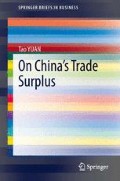Abstract
Because Chinese foreign trade scale grows rapidly and trade surplus of China continues, there are increasing trade frictions between China and its trade partners. Handling trade frictions with trade partners appropriately has a great influence on Chinese foreign trade and economic growth. It is unreasonable for china to restrain exports to pursue trade balance and reduce trade frictions. In order to reduce trade frictions with trade partners, we think China can take some measures as: encouraging imports instead of reducing exports, encouraging OFDI (outward foreign direct investment) of Chinese enterprises and exporting parts and components to host countries, asking for more imports of high-tech products from the U.S. and the European Union, and encouraging exports of high-tech products with intellectual property rights.
Access this chapter
Tax calculation will be finalised at checkout
Purchases are for personal use only
Notes
- 1.
See the Madrid European Council, Presidency Conclusions, June 27, 1989,
- 2.
Tokyo Shimbun, February 9, 2005, via FBIS.
- 3.
The two-day S&ED is co-chaired by Chinese Vice Premier Wang Qishan, State Councilor Dai Bingguo and U.S. Secretary of State Hillary Clinton and Treasury Secretary Timothy Geithner. The dialogue mechanism was upgraded from former Strategic Dialogue and biennial Strategic Economic Dialogue, which were initiated by the two heads of state in 2005 and 2006, respectively.
References
State Administration of Foreign Exchange of the People’s Republic of China (SAFE) (2011) Report on the balance of payments 2011, p 9 (in Chinese)
Mundell R (1957) International trade and factor mobility. Am Econ Rev 67:321–335
Kojima K (1977) Direct foreign investment between advanced specialized countries. Hitotsubashi Journal of Economic, 28:1–18
Kojima K (1978) Foreign direct investment: a Japanese model of multinational business operations. Croom Helm, London
Markusen JR, Svensson LEO (1985) Trade in goods and factors with international differences in technology. Int Econ Rev 26(1):175–192
Bhagwati JN (1987) Trade and development theory and policy: a synthesis exists. Econ Political Weekly 22:859–860
Yuan T (2009) Economic effect of anti-dumping: analysis on China. People’s Publishing House, Beijing
Bureau of Industry and Security of the U.S. Department of Commerce (2011) Export control reform initiative: strategic trade authorization license exception, Federal Register, vol 76, No. 116, Thursday, June 16, 2011, rules and regulations, p 35278
Author information
Authors and Affiliations
Corresponding author
Appendix
Appendix
Rights and permissions
Copyright information
© 2014 The Author(s)
About this chapter
Cite this chapter
Yuan, T. (2014). To Reduce Trade Frictions. In: On China's Trade Surplus. SpringerBriefs in Business. Springer, Berlin, Heidelberg. https://doi.org/10.1007/978-3-642-38925-2_4
Download citation
DOI: https://doi.org/10.1007/978-3-642-38925-2_4
Published:
Publisher Name: Springer, Berlin, Heidelberg
Print ISBN: 978-3-642-38924-5
Online ISBN: 978-3-642-38925-2
eBook Packages: Business and EconomicsBusiness and Management (R0)

